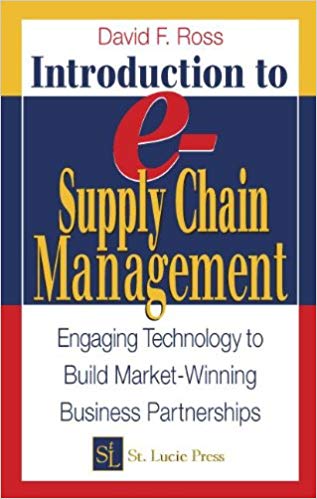Overview
Introduction to e-Supply Chain Management is Engaging Technology to Build Market-Winning Business Partnerships shows you how to exploit this merger and gain an unbeatable competitive advantage
The tightening of the economy and heavier restrictions and security measures placed on channel flows
have rendered access to real-time, accurate supply chain information more critical than ever Connectivity, messaging, and collaboration have become today's foremost buzzwords, as companies compete for survival in an environment where cycle times and permissible margins of error continue to shrink Introduction to e-Supply Chain Management explores the concepts, techniques, and vocabulary of the convergence of SCM and the Internet so that companies can move beyond merely surviving and thrive in today's competitive marketplace

Table of Contents
The Advent of Supply Chain Management: Architecting the Supply Chain for Competitive Advantage I The Rise of Supply Chain Management - II Evolution of Supply Chain Management - Historical Beginnings - Stages of Supply Chain Management Development - First Stage - Logistics Decentralization - Second Stage - Total Cost Management - Third Stage - Integrated Functions - Fourth Stage - Supply Chain Management - Fifth Stage - e-Supply Chain Management - III Defining e-Supply Chain Management - SCM Definitions - e-SCM Definition - IV Characteristics of e-SCM - e-SCM Enables a Whole New View of the Function of Information in the Supply Chain - Utilization of e-Information - Supply Chain Event Management - Real Options Management - Supply Chain Systems Integration - Collaborative Relationships - e-SCM Enables Enterprises to Form Customer-Winning Relationships with Supply Chain Partners - Establish a Web-Enabled Network of Channel Partners - Network-In Customers - Accelerate and Improve Decision-Making by Integrating Business Partners - Meeting Customer Expectations - Supply Chain Synchronization: Timing Is Everything! - Develop a Supply Chain Strategy that Provides for Avenues of Ongoing Supply Chain Synchronization Provide for the Establishment of Avenues for e-SCS Operations Excellence - Identify and Implement the Right Enabling Technologies - Design and Implement New Forms for Organizational Relationships - Summary and Transition – Endnotes
The e-Business Economic Revolution: The Components and Impact of e-Business - Rise of the New Economy - Understanding the Internet Business Environment - Customer Management Dynamics -Product Cycle Management Dynamics - - Information Technology Dynamics - Global Channel Dynamics - Logistics Dynamics III Principles of The e-Business Age - - Defining Terms - e-Business - e-Commerce - - e-Fulfilment Business-to-Business (BB) - e-Procurement Business-to-Customer (BC) - Collaborative Commerce (c-Commerce) - Trading Exchanges - - e-Collaboration Is at the Heart of e-Business - Defining e-Business Collaboration - c-Commerce at Manco Working with the Realities of Supply Chain Collaboration - Security, Trust, and Branding: Keys to c-Commerce Success - Rise of New Forms of e-Business - Impact of e-Business on the Human Resources - e-Supply Chain Business Trends - - Continued Migration from Vertical to Virtually Integrated Enterprises - e-Business Expansion Will Continue - - Expanding Customer Relationship Management - Increased Emphasis on Business Collaboration - Increased Importance of Logistics - Summary and Transition
Constructing the e-Business Model: Exploring the Anatomy of Todays e-Business Solutions - Enterprise Systems Foundation - EBS: the Backbone of the Enterprise - Criticisms of EBS - The Rise of Internet Commerce - Electronic Data Interchange (EDI): First Contact - - Rise of Internet Connectivity - Marketing - e-Commerce Storefront - e-Business Marketplaces - Independent Trading Exchanges (ITXs) - Private Trading Exchanges (PTXs) - Consortia Trading Exchanges (CTX) - e-Collaboration Marketplaces - Todays e-Business Marketplaces – Summary - e-Business System Architecture - e-SCM Business System Model - e-Business Integration Frameworks - Summary and Transition
Developing e-SCM Strategies: Creating the Game Plan for e-SCM Success - Changing Views of Enterprise Strategy – Overview - The Primacy of Value Chains - Barriers to e-SCM - Preliminary Steps In e-SCM Strategy Development - Opening Issues in e-SCM Strategy Development - Preliminary Steps - Step - : Energize the Organization - Step - : Enterprise Vision - Step : Supply Chain Value Assessment - Step - : Opportunity Identification - Step : Strategy Decision - Developing the e-SCM Strategy Constructing the Business Value Proposition - Defining the Value Portfolio - Structuring the Scope of Collaboration - Ensuring Effective Resource Management - Pursuing Growth Management - Focus on Supply Chain Costs - Focus on Supply Chain Value - Design an Effective Performance Measurements Program
Customer and Service Management: Utilizing CRM to Drive Value to the Customer - Creating the Customer Centric Supply Chain - The Advent of Customer Relationship Management (CRM) - CRM Is a Strategic Tool - CRM Is Focused on Facilitating the Customer Service Process - CRM Is Focused on Optimizing the Customers - Experience - CRM Provides a Window into the Customer - CRM Assists Suppliers to Measure Customer Profitability - CRM Is About Partnership Management - CRM Is a Major Facilitator of Supply Chain Collaboration - Mapping the Cluster of CRM Components C Understanding Todays Customer Dynamics - Creating the Customer-Centric Organization - Establish a Customer-Centric Organization - Determine Existing Customer Positioning - Devise a Map of Customer Segments - Develop and Implement the Solution - Monitor, Measure, and Refine - II Applying Technology To CRM - CRM and Internet Sales - Sales Force Automation (SFA) - e-CRM Marketing - e-Marketing at Borders - Customer Service Management (CSM) - CRM And the Supply Chain - Partner Relationship Management (PRM) - Partner Recruitment, Development, and Profiling - Marketing Development - Sales Management - Services Management - PRM Collaboration - Electronic Bill Presentment and Payment (EBPP) CRM Analytics Implementing CRM IV Summary and Transition – Endnotes
Manufacturing and Supply Chain Planning: Linking Product Design, Manufacture, and Planning to Provide Value to Customers - Manufacturing in the Age of e-Business - Dominance of the Customer - The Centripetal Forces of Time and Change - Manufacturing/Supply Chain Infrastructure Change - Changing Performance Targets - Impact of Technology on Manufacturing - Short History of Manufacturing Planning and Control Systems - Geography of Todays Manufacturing Systems - Manufacturing Planning - Production and Process Management - Product Design and Engineering - Plant Maintenance and Quality Management - Product Life Cycle Management (PLM) - Impact of e-Business - Manufacturing Process Synchronization - Supplier Management - Internet-Driven Design Collaboration - Current State of e-Business and Manufacturing - III Collaborative Product Commerce - - Defining CPC - CPC at the Stephen Gould Company - Linking Supply Chain Design Capabilities - Detailing the Contents of CPC - IV Managing Manufacturing Planning Functions - Advanced Production and Scheduling Systems - Accurate Data - Planning Timeframe - Planning Model - Schedule Management - Supply Chain Optimization Tools - Accurate Data - Planning Timeframe - Planning Model - Optimization Techniques - Schedule Management - Collaborative Planning, Forecasting, and Replenishment (CPFR) - Summary and Transition – Endnotes
Supplier Relationship Management: Integrating Suppliers into the e-Value Chain - I Defining Purchasing and Supplier Relationship Management - Defining the Purchasing Function - Defining SRM - Components of SRM - Strategic Sourcing and Supply Management - Applying Technology to the Management of SRM - SRM-Driven Infrastructures and Operations - The Internet-Driven SRM Environment - e-SRM Structural Overview - EBS Backbone Functions - Procurement History - Accounting - Purchasing Planning - Performance Measurement - e-SRM Services Functions - Supplier Search - Product Search - Strategic Sourcing - Value-Added Services - e-SRM Processing - Product CatLog Management - Requisitioning - RFQ - Shopping Tools - Auctions - Purchase Order Generation and Tracking - Logistics - e-SRM Technology Services - Web Processing - Security - Member Services - Content Search and Management - Workflow - III Anatomy of The e-SRM Marketplace Exchange Environment A Emergence of Todays e-Marketplace - Foundations - Rise of Collaborative Commerce - Development of Networked Exchanges B Defining the Trading Exchange - Future of B2B e-Marketplaces IV Implementing e-SRM - e-SRM Value Discovery - Infrastructure Analysis - Preparing for Organizational Change - Spend Analysis - Item/Service Analysis - e-SRM Technology Choices - Hosted Supply Chain (HSC) - Automation Applications - Portals - Exchanges and Auctions - PTXs and CTXs - G Performance Measurement V Summary and Transition – Endnotes
Logistics Resource Management: Utilizing the Internet to Enhance Logistics Competitive Advantage - Defining Logistics Resource Management - A Logistics Performance Management - Fulfilment Planning and Execution - Logistics Partnership Management - Shipment Visibility - Fulfilment Event Management - Dealing With Logistics Uncertainties II Defining LRM in the Age of e-Business - e-LRM Foundations - Anatomy of e-LRM Functions - Enterprise Performance Measurement - Warehouse Management - Transportation Management C Studies in e-LRM - e-LRM at Herman Miller - NextJetcom: e-LRM in the Jet Stream - III Understanding the Third-Party Logistics Network - Role of the PL - Internet-Driven LSPs - Todays LSP Marketplace Challenges - IV Choosing and Implementing an LSP Solution - LSP Business Models - Steps in LRM Strategy Development - Logistics Analysis - Support for the Customer Strategy - Select a Technology Solution - Gain Company Buy-in - Start Small - Performance Measurements - Strength of the LSP - Select a Compatible Technology Solution - Controlling Information - Services and Capabilities - Customer Success V Summary and Transition
Architecting the e-SCM Environment: Organizational and Technical Requirements for e-SCM Success - Foundations of e-SCM Technology Architecture - Enterprise Business Architecture - Organizational Task Management - Customer-Focused - Reengineering of Workforce Roles - Managing the Workforce - Developing the virtual Organization Inter-Enterprise Business Architecture - Architecting a Shared Inter-Enterprise Vision - Inter-Enterprise Business Modelling - Inter-Enterprise Process Modelling - Inter-Enterprise Technology Architecture - e-SCM Technical Vocabulary - Technology Foundations for Next-Generation Interoperability - Todays e-SCM Technical Architecture - The Future of e-SCM - Changing Face of Information Management - New Generation of Business Applications - Application Service Providers (ASP) - Wireless - Transforming the Organization to the e-SCM Environment - Supply Chain Efficiency - e-SCM Integration - Collaborative Convergence
Review from Venkadesh Narayanan, Principal Consultant, Fhyzics










